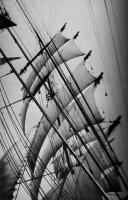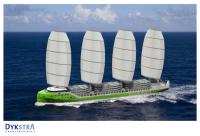
Windjammer British Isles, inspiration for the Lady Rebecca
My novel Hell around the Horn is set on a British windjammer on a voyage around Cape Horn in the particularly brutal winter of 1905. I wanted to write the novel, in part, because the windjammers have been largely forgotten in these days when any vessel that sets square sails is too often simply called a “pirate ship.” The windjammers were perhaps the greatest sailing vessels ever to cross the oceans. These ships and those who sailed them, deserve better.
William Faulkner once wrote, “the past isn’t dead it isn’t even past.” The same can be said of windjammers. While too often forgotten, they are not yet dead, and they certainly are not past.
But what was a “windjammer?”
After steam ships were able to attract the high value cargoes that once were carried under sail by clipper ships, the owners of sailing ships shifted their focus to trades where the steam ships still could not compete. They bean to build large sailing ships designed to carry bulk cargoes on the long windy passages where steam ships could not because of the cost fuel and the lack of coaling stations. These ships, built of iron or steel, were several times larger than the wooden-hulled clippers. Unlike the clipper ships which often carried crews of 80 or more, these new large ships were sailed with crews of only around 30. They were among the largest and most efficient cargo carriers of their day. The newspapers called them “windjammers.” The term was never liked by the shipowners or sailors, but the name stuck. In my novel, Hell Around the the Horn, the fictional ship Lady Rebecca is based on the actual ship, British Isles, a steel three masted full rigged ship built in Port Glasgow in 1884.
While it is easy to look back at windjammers now as old fashioned and an anachronistic part of an another time, in their day they were highly advanced and efficient machines for transporting cargoes across the oceans. Alan Villiers; the sailing ship captain, author and film-maker; described one windjammer as, “It’s a big Cape horn ship, a steel vessel carrying 3,000 tonnes, with a crew of only thirty or less, fewer people, doing more work, more effectively, bigger ship, carrying more goods,…more cheaply, and yet of course…facing the ruin that came with the powered ship and put them all out of business.” If the windjammers were so efficient and so cheap to operate, why did the “powered ship …put them out of business?” There are many answers to that questions, but the most compelling is the simplest. Cheap energy. In the 1880s the price of oil fell to, in inflation adjusted terms, around $20 per barrel and stayed there for close to a hundred. Even the most efficient windjammer couldn’t compete.
Nevertheless, the windjammers hung on. They continued making money for their owners well into the twentieth century. The last commercial cargo carrying voyage by a windjammer was in 1957. Several windjammers are still sailing today, as training and schools ships. The Russian training ship Kruzenshtern, was built in 1926 as the Pauda for the Flying P-Line. Likewise, the Russian train training ship Sedov, was originally the German windjammer the Magdalene Vinnen II built in 1921. Several dozen windjammers have been preserved as museum ships around the world.

A modern windjammer designed for Fairtransport
I suggested earlier that the largest single reason that the windjammers have largely left the seas is because of cheap energy. For close to century, oil prices hovered around $20 a barrel in today’s dollars. This morning the price of oil is over $100 a barrel. The era of cheap energy may be behind us. A new generation of ship owners and ship designers are looking seriously again at wind ships. Will we see the return of the windjammer? I wouldn’t bet against it.
Writers aboard the Blog Hop – do please pay them all a visit!
- J.M Aucoin
- Helen Hollick
- Doug Boren
- Linda Collison
- Margaret Muir
- Julian Stockwin
- Anna Belfrage
- Andy Millen
- V.E. Ulett
- T.S. Rhodes
- Mark Patton
- Alaric Bond
- Ginger Myrick
- Judith Starkston
- Seymour Hamilton
- Rick Spilman
- James L Nelson
- S.J. Turney
- Prue Batten
- Antoine Vanner
- Joan Druett
- Edward James
- Nighthawk News

Excellent post, Richard, and it’s high time they make a return. “Green”, clean, and efficient, these ships are. You certainly brought Lady Rebecca to life in your historical novel, Hell Around the Horn. Looking forward to reading more about windjammers, in all their glory.
While these ships were temporarily out of the picture we’ve made huge leaps in materials science, structural engineering, aerodynamics, automation. The next generation will do even more with with even less.
It’s an encouraging thought, to think of modern transport being powered by the wind. But boy, are the originals far more pleasing to the eye!
Pingback: The Old Salt Blog » Key West Bobby B